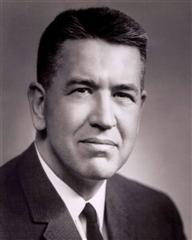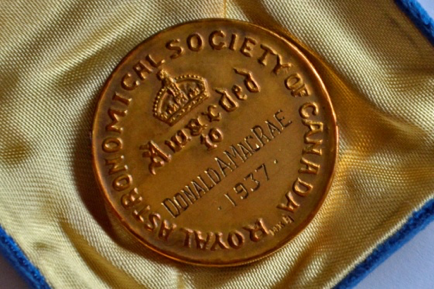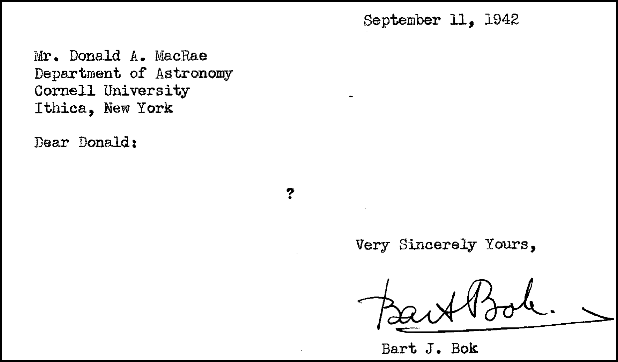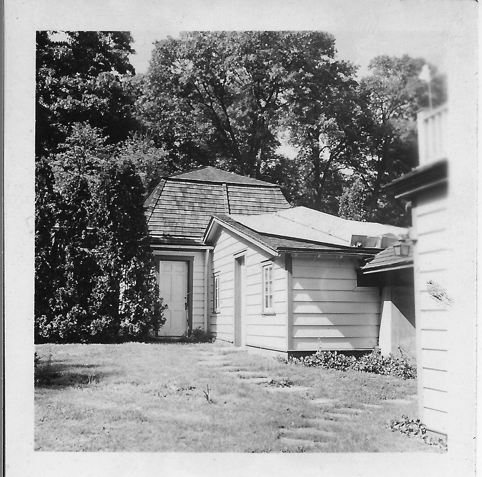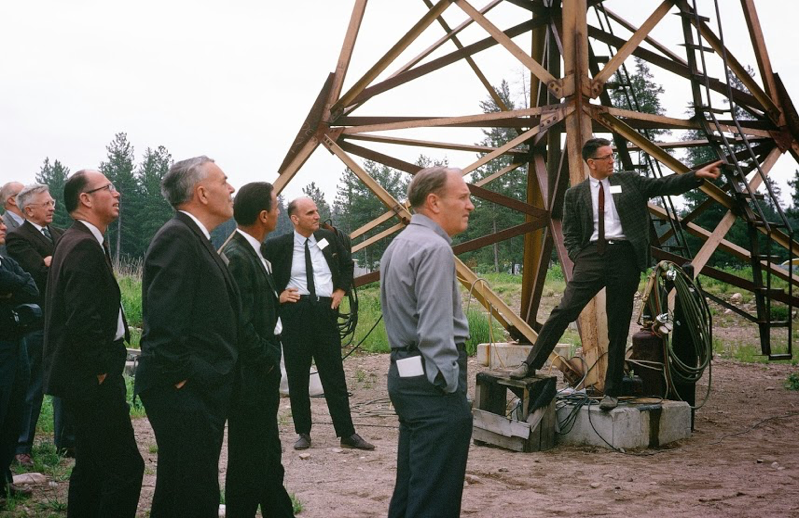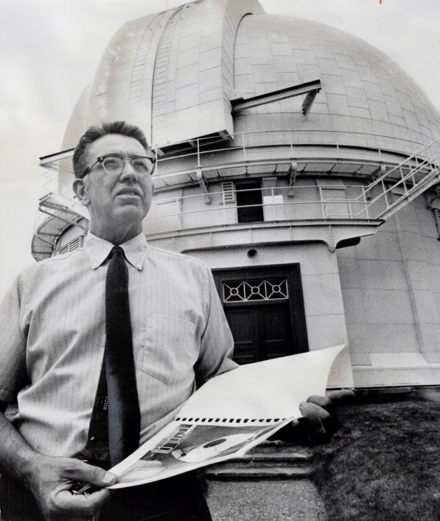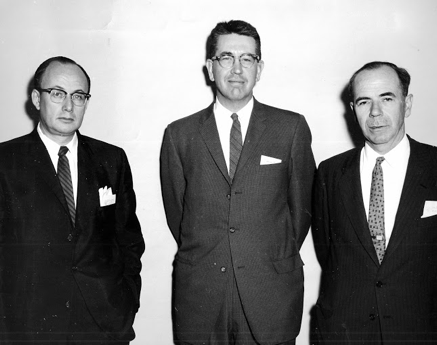
Donald Alexander MacRae (1916-2006)
Donald Alexander MacRae (“Don” to his friends) was Chair of the Department of Astronomy and Director of the David Dunlap Observatory, and a leader in the Canadian astronomical community. Born in Halifax, his early career was spent in the U.S., earning a PhD with Bart Bok at Harvard, and holding positions at several prominent U.S. universities. He also had a brief association with the Manhattan Project while at Carbide and Chemical Corporation at Oak Ridge, Tennessee. In 1953, after a stay at Case Western Reserve University, he accepted a position at the University of Toronto, where he remained for the rest of his career. Don’s legacy at Toronto includes his leadership in inspiring and developing new research directions at Toronto and in the rest of Canada. He introduced innovative methods in undergraduate education and public outreach. He was among the first at the university to introduce the use of computers in regular undergraduate courses, and together with the Department of Electrical Engineering, he established a radio astronomy program at the university. During his service as Chair and Director from 1965 to 1978, he expanded the Observatory to include a 24 inch telescope at Las Campanas, Chile – the first ever Canadian offshore observatory facility.
Don retired in 1982, and in 2004 the university established the Donald MacRae Scholarship to honour his contributions to education. For a brief outline of Don’s career biography, see the Biographical Summary.
Biographical summary
Biographical summary
Education
Huron Street Public School and University of Toronto Schools, Toronto
University of Toronto B.A. 1937
Harvard University AM 1940
Harvard University Ph.D. 1943
Employment
1941-42 University of Pennsylvania (Philadelphia)
1942-44 Instructor, Cornell University
1944-45 Scientist, Carbide Carbon Chemical Corp., Oakridge, Tennessee
1946-53 Assistant Professor, Case Institute of Technology (Cleveland)
1953-55 Associate Professor, University of Toronto
1955-82 Professor, University of Toronto
1964-65 Associate Head of the Department of Astronomy, University of Toronto and Assistant Director of the David Dunlap Observatory
1965-78 Chairman of the Department of Astronomy, University of Toronto and Director, David Dunlap Observatory
1982 Professor Emeritus
Other Activities
1962 Fellow, Royal Society of Canada
1963-66 American Astronomical Society: Councilor
1967-73 Member of Board of Trustees of the Universities Space Research Corporation, Chair in 1973
1969-76 Member of the Lunar and Planetary Institute, Houston, Texas
1973-79 Member of the Canada-France-Hawaii Telescope Corporation, Chair in 1978-79
Early Career Events by David M.MacRae
Early Career Events by David M.MacRae
Donald Alexander MacRae (known to his friends as “Don”) was born in Halifax, Nova Scotia, in 1916. His father (also named Donald A. MacRae) was a classics scholar, a lawyer, and at that time, the Dean of the Dalhousie Law School. Don’s family moved to Toronto in 1924 when his father was appointed as a lecturer at what is now Osgoode Hall Law School (associated with York University).
Don’s association with the University of Toronto began in his years at the University of Toronto Schools (UTS).
In 1933, he enrolled in Mathematics & Physics at UofT, graduating with honours from Victoria College in 1937. He was awarded a Victoria College Regents Scholarship in his 3rd year and in 1937, upon graduation, a Gold Medal from the Royal Astronomical Society of Canada (see left). His career interest in Astronomy clearly was already well developed.
In the fall of 1938 he enrolled in the graduate program in Astronomy at the Harvard College Observatory and in 1939, Don and Elizabeth (Betty) Malcolm (daughter of Reverend Charles & Margaret Malcolm of Chatham, Ontario) were married.
In 1941, with a child on the way, Don accepted a 9-month research assistant position at the University of Pennsylvania while writing up his thesis. He worked for Charles P. Olivier at the Flower and Cook observatories, maintaining a fairly intensive observing schedule until September 1942. Don’s activities were mostly at the Cook facility (shown here in a photograph taken by Don at the time) that housed the 15-inch refractor siderostat. In addition to Olivier’s photometry efforts, Don also assisted Olivier in the preparation of two papers concerned with meteor and fireball studies.
At the end of the fellowship in Philadelphia, and shortly before defending his Ph.D. thesis, Don and the family moved to Cornell University in Ithaca, NY, to work for R. William Shaw. Shaw ran a 3-person astronomy department, whose main focus was teaching. Don, as the third person in the Cornell department, was asked to teach statistical astronomy, math and physics, as well as a course in celestial navigation. The latter was part of a huge effort during World War II to educate 100,000 new naval officers in the basics of physics and navigation. There were civilians too, including two nuns under the Engineering, Science & Management War Training Program. What time was left, he could use for research….
It was at Cornell that two key long-term professional relationships were serendipitously developed. One was with Charles Seeger, who turned out to occupy the apartment upstairs from Don and Betty. Seeger was an electrical engineer who had become interested in the significance of “cosmic static”, and was building early receivers to explore those signals. Don’s interests in radio astronomy, and the benefits of cross-disciplinary collaboration that were so important in his later years in Toronto, no doubt had their origins from discussions that were held around the neighbouring MacRae and Seeger dining room tables.
The other Cornell connection was with Don’s colleague and friend Ralph Williamson, who later came to UofT in 1946, and stayed until 1953. Ralph was a theoretical astronomer with a developing interest in radio astronomy who also collaborated with Seeger at Cornell.
In late 1944 it was possible to see the eventual end of the program at Cornell. A long-time friend of Don’s, Everet Minett, who was also an alumnus of UTS and the Maths & Physics program at UofT, arranged for Don to receive an offer of a position with Carbide and Carbon Chemicals Corp (Union Carbide) in “Tennessee” as a Research Associate Physicist. The precise destination and objectives were cloaked in secrecy, and while Don understood that the job was part of the war effort, his best guess before he got there was that it had something to do with synthetic rubber! The job turned out to be in the secret city of Oak Ridge as part of the Manhattan Project, and his job involved research into methods for characterizing and real-time monitoring of the gaseous diffusion process for uranium enrichment.
General Leslie Groves, who headed the Manhattan Project, liked to say of the diverse backgrounds of those contributing to the effort that “We even have a sanitary engineer and an astronomer down here!”.
After August of 1945, implications of any nuclear war became of acute concern. Everet Minett became Executive Director of the Emergency Committee of Atomic Scientists (ECAS), an organization spearheaded by Albert Einstein. Their mission was to educate the public regarding the dangers of atomic warfare. Many members were scientists who worked on the Manhattan Project, and who also had belonged to the Oak Ridge Engineers and Scientists (ORES) that had similar objectives. Don was the head of the Planning Committee for the ORES. ECAS disbanded in 1952. The University of Chicago now holds the historical files of the ECAS and those of the ORES that came from Don’s files.
In 1946, while contemplating his desired return to Astronomy and an academic life, offers came from UofT and Case Western Reserve among others, and were being weighed in the same time frame. In the end, the timing of the Toronto offer did not work out for Don and he recommended Ralph Williamson to Frank Hogg as a good candidate for the U of T Astronomy Department. Williamson joined the faculty in Toronto from Cornell in 1946.
In September of 1946, Don joined the faculty at Case Western Reserve and the Warner & Swasey Observatory (headed by Jason J. Nassau) as Assistant Professor of Astronomy. Another colleague at Case was Sidney McCuskey, also a Harvard astronomy alumnus (1936). He was the head of the mathematics department at Case, but spent a lot of time on astronomical research.
At Case, Don was responsible for a moderate teaching load (Calculus and Astronomy) and a fairly significant observing schedule. Evidently he was on deck for about half of the observing time on the relatively new 24-inch Burrell Schmidt telescope that was built in 1939. Dawn arrivals at home were common.
The Case experience was the definitive platform for Don’s return to Astronomy, and the time in Cleveland became the true beginning of his academic career. He became active in the American Association for the Advancement of Science, and the American Astronomical Society, delivering papers to each within a short period of his arrival. The Cleveland press was alert to astronomical developments that were associated with Case, and often reported on the activities of the Warner and Swasey astronomers.
By 1953, the desire to return to Canada with all of its family connections became stronger. An offer from the Dominion Astrophysical Observatory was entertained, but once again the connection with Williamson was a factor. Ralph had announced his impending departure from the Toronto department. As a consequence, an offer was extended for Don to accept a position of Associate Professor, beginning in September of 1953. The offer was, of course, accepted.
Research Interest
Research Interest
Don MacRae’s research interests were broad, ranging from spectral classification and the spectra of peculiar A stars, the nature of the lunar soil (including the period prior to the lunar sample program), to various initiatives in radio astronomy.
His earliest work in spectral classification (around the time he arrived at Toronto) was focused on objective prism surveys which provided classification of photometric standard sequence stars. His later work in this area was on stars whose spectra somehow deviated from the normal pattern found in the standard spectral sequence, especially the Peculiar A stars.
One of his most intense interests in the 1960’s was in the nature of the lunar soil. He suggested that the lunar soil was comprised of a conglomerate containing water ice – a product of the material from which the Moon was formed. The argument was informed by the similarity between certain lunar features and terrestrial “pingos” (domes containing subsurface ice) seen in the Canadian arctic. Though his ideas did not gain a wide following, the subject of ice on the Moon has now captured a renewed interest. Recent radar measurements from spacecraft orbiting the Moon have revealed evidence for ice in permanently shadowed regions of craters in its polar regions.
Another of Don’s primary interests was radio astronomy, likely stemming largely from influences by radio astronomers during his stay at Cornell. In collaboration with J.L. (Allen) Yen of the Department of Electrical Engineering (E.E.), he established a program based at the David Dunlap Observatory to provide a center for training Astronomy and E.E. students in radio astronomy. The primary focus of this work was the measurement of the absolute flux densities of the Sun and discrete cosmic sources, as well as the absolute brightness of selected regions of diffuse radio emission from the Milky Way. The purpose of much of this work was to establish absolute standards of reference which could be used to calibrate larger source surveys.
Don’s larger plan was to move the operation to a University of Toronto site at the newly established Algonquin Radio Observatory (ARO), to include an interferometer comprising two 60 foot dishes. This work was begun, but never reached fruition because of the changing times in which government funds were focused instead on building larger national radio facilities such as the NRC 150 foot radio telescope at ARO.
The image (photo courtesy of the Jack Locke Collection) shows Don MacRae guiding a tour of the first University of Toronto 60 foot radio telescope site at ARO. The occasion was a site visit associated with a meeting in Ottawa of the Canadian National Committee to the IAU in October, 1968. Others shown are unrecognized except for Bill Wehlau of the University of Western Ontario (third from the left).
Don’s leadership in radio astronomy has left a powerful and lasting legacy. This legacy included Toronto leadership in the first successful Long Baseline Interferometer experiment in 1967 between antennas at ARO and the Dominion Radio Astrophysical Observatory near Penticton, B.C. Don’s leadership also spawned an enduring radio astronomy research program at Toronto which produced many PhDs in the field. Interest in radio astronomy subsequently expanded into CITA and the Dunlap Institute which are now helping to pioneer such new radio facilities as CHIME and the SKA. CHIME, located at the Dominion Radio Astrophysical Observatory, is a leading edge radio telescope for cosmological and pulsar research. The SKA, under development by a large international consortium for construction split between Australia and South Africa, will be the single most powerful radio telescope in the world when completed in about a decade.
Teaching and Public Outreach
Teaching and Public Outreach
As a teacher, Don was dedicated both to his students and to the broader public. He worked hard to ensure that non-specialist students were exposed to the best education possible; in his specialist courses he ensured that students were well rounded and grounded. To be an astronomer meant to him not only to have an intensive knowledge of modern astrophysics, but also exposure to the greatest breadth in the field. For example he taught the techniques of making astronomical measurements, the effects of luni-solar precession, celestial navigation, and the basis for determining astronomical and civil time. As a result, graduates of Toronto acquired a unique perspective on astronomy not accessible at other Canadian institutions where astronomy was taught primarily in physics departments. He was known to say that future astronomers trained elsewhere would be so specialized that they would lack this broader perspective. Of course he was right.
Don was particularly innovative in introducing new subject areas (e.g. radio astronomy) and teaching methods (e.g. computers) as they emerged in the field. He is also regarded as the first professor at Toronto to introduce the use of computers as part of the regular curriculum. He took great interest in FERUT, the university’s first computer, and offered access to it for astronomical computation by astronomy students. In addition, he was a key influence in the acquisition of the McLaughlin Planetarium for the city of Toronto, and in particular for its use as a teaching tool in undergraduate courses. During his time as Chair he also introduced a broad range of new telescopes and equipment for the undergraduate laboratories.
In a department recognized for its outstanding teachers like Helen Hogg and Sidney van den Bergh, Don was well liked by students for his organized lectures, fairness in evaluation, and for his dry wit both in and out of class. To Don, ability in teaching was a most important quality in hiring, and he paid strict attention to this aspect as he oversaw the explosive growth of the teaching faculty during his term as Chair. He was also particularly supportive of women in science at a time when women were not encouraged to study this subject. This attitude had a positive impact on the number of women in the graduate program at Toronto.
Another of Don’s keen interests was public education and outreach. As well as helping to bring the McLaughlin Planetarium to the city, as Director of the David Dunlap Observatory he saw that this facility was fully utilized for public awareness of astronomy, and he directed with imagination the use of departmental endowment funds for programs engaging the visiting public. Departmental graduate students were trained and employed to conduct tours of the 74-inch telescope. Don himself gave lectures to the public, and always added an air of distinction to the role of the astronomer. The most well-known of Don’s contributions in this area was his starring role in the acclaimed 1960 NFB film “Universe” which was nominated for an academy award. The movie shows him during a nightlong vigil at the David Dunlap Observatory, during which the audience is treated to an informative and spectacular tour of the universe. This film has garnered several awards, and included some of the best special effects of its time. With his classic sense of humour, Don is shown in the photo accepting a light-hearted award of “Best Astronomical Actor of 1960” by observatory staff and students on the occasion of the success of this hallmark film.
The National Film Board Movie: “Universe” – Throughout his career, Dr. MacRae was a strong supporter of public outreach. He was the astronomer depicted in the National Film Board’s 1960 Oscar-nominated short film “Universe”. The movie shows him during a nightlong vigil at the David Dunlap Observatory. This film has garnered several awards.
Leadership in Canadian Astronomy
Leadership in Canadian Astronomy
One of Don MacRae’s interests was to bring new ideas and capabilities to both the Department of Astronomy and to the larger astronomy community in Canada. He developed an early interest in space astronomy, probably associated in part with his strong interest in the future of lunar exploration. He took steps to ensure the Department was represented on the NRC Associate Committee for Space Research, and in the early 1960’s he invited members of the US Space Agency to Toronto to talk about the use of space probes and satellites in astronomy. The image, dated October 1961, shows one of these visitors – Dr. Benjamin Milwitsky (left) – together with Don and Observatory Director Jack Heard on the occasion of Milwitsky’s visit. Dr. Milwitsky was an influential member of NASA during its formative years and was later appointed Manager for the NASA Lunar Surveyor Program. Don was also a member of the Board of Trustees of US Universities Space Research Corporation for many years in the late 60’s and early 70’s, and served as Board Chair in 1973. He was also a member of the Lunar and Planetary Institute in Houston, Texas during the period 1969-76.
With the strong support of optical astronomers in the department, Don as Chair and Director oversaw the establishment of a new University of Toronto observing site on Cerro Las Campanas, Chile in 1970. With the cooperation of the Carnegie Institution of Washington, a 24-inch telescope was placed on the site providing access to the southern skies by faculty and students of the department as well as visiting observers from other institutions. One of the principal motivations for Las Campanas was the quality of this site for astronomical observations. Don’s belief on the importance of the site was translated into a strong advocacy for placing any new Canadian national observatory at excellent sites. This came to fruition with the Canada France Hawaii Telescope (CFHT) at Mauna Kea in 1979. Don played a strong role in the development of the CFHT. He served on the CFHT Corporate Board for the six years leading up to first light, and was its Chair in 1978-79. The photo shows a group photo of the Board taken during its meeting at Laval University in 1979.




